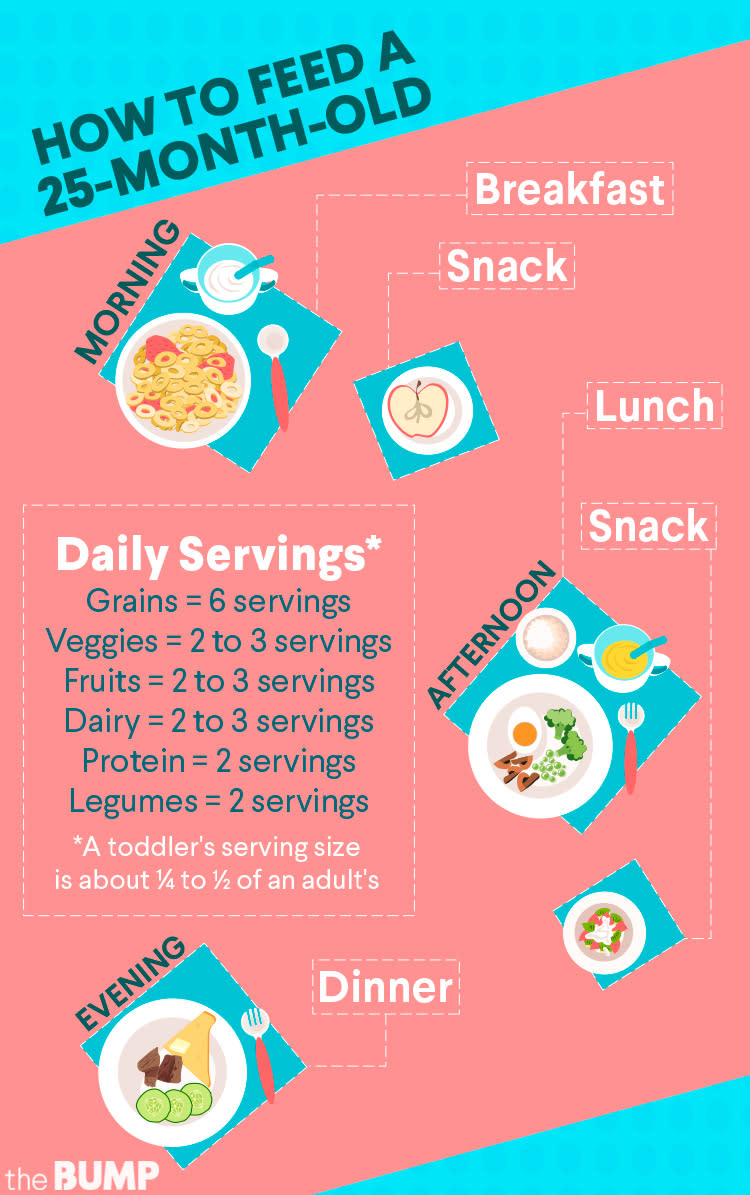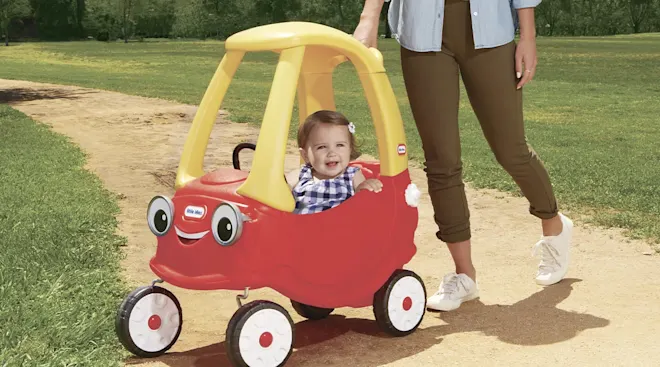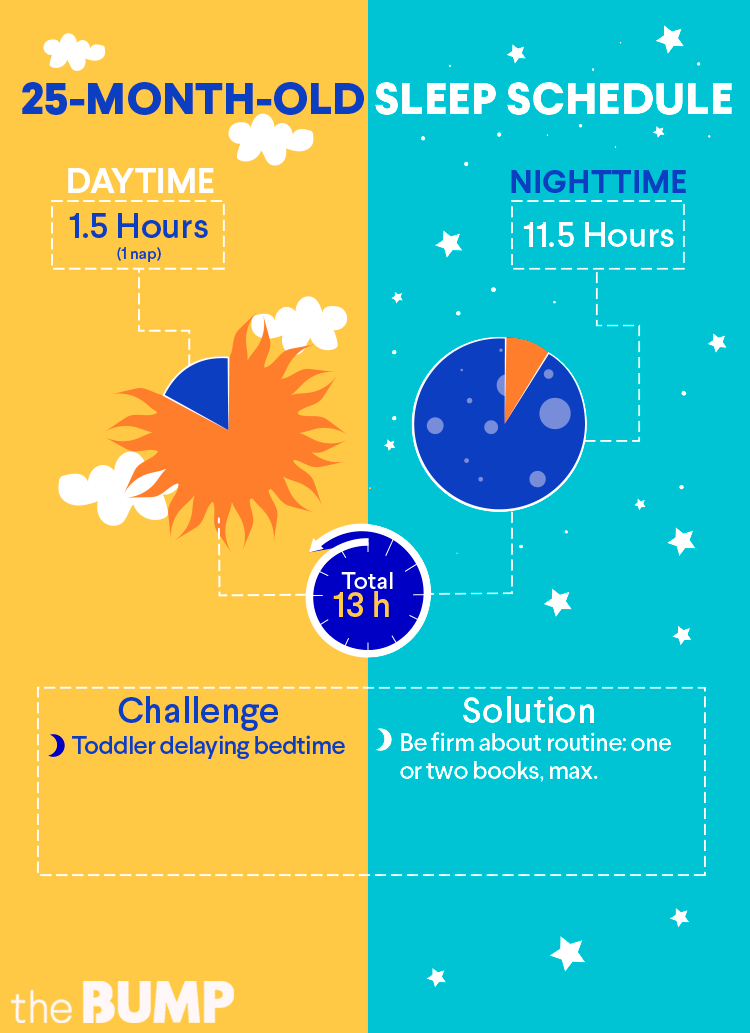Has your 25-month-old toddler started to exert their independence? We’re talking about stomping, screaming, defying and all those other frustrating (and totally normal for this age) behaviors. Two-year-olds are possibly the most stubborn, self-centered creatures on earth. They want what they want, when they want it—usually, right now! The good news is your child’s stubborn streak means they’re going through a ton of cognitive growth. They now understand that they’re a separate person who can make things happen in the world. So of course, they’re making them happen. Rest assured that eventually, things will get less, um, dramatic.
In addition to their (sometimes frustrating) personality, your 25-month-old's body and brain continue to grow and develop in a variety of ways. You’ll notice that your 25-month-old baby can now play simple make-believe games, memorize parts of familiar books, rhymes or songs and identify and point to objects in a book. You’ll also notice your kiddo reaching new 25-month-old milestones in language, movement and socialization.
25-month-old weight and height
Average weight for a 25-month- old is around 27.1 pounds for girls and 28.4 pounds for boys. Average height is around 34 inches for girls and 34.5 inches for boys, according to the US Centers for Disease Control and Prevention (CDC). As always, the most important thing is that your 25-month-old baby remains where they should be on their own growth chart, which your pediatrician will track for you.
25-month-old milestones
There are some pretty exciting 25-month-old milestones that both you and your little one can look forward to. Whether baby is working on language development, playing with others or moving and shaking, your 25-month-old is doing a lot! Here are some milestones your 25-month-old may have hit or may be working on:
- Speech. Your 25-month-old probably uses simple phrases and may be saying two-to-three-word sentences. Most 2-year-olds are able to say 50 to 100 words. If your 25-month-old isn’t talking or using phrases with two words, let your pediatrician know. Some kids simply need more time; others may have a hearing problem or may benefit from an early intervention program. Help your 25-month-old work on their language development by having conversations with them, talking through your day and reading to them.
- Potty training. If your 25-month-old is showing interest in potty training, this might be one of the most momentous 25-month-old milestones! However, while some kids are ready to begin potty training at 25 months, plenty of others aren’t. Let your child lead the way, because if you try to push the issue, you’ll just end up losing to a very stubborn toddler. Watch for signs of readiness and reward any small successes, like sitting on the potty, if only for a few moments.
- Teething. Your child may be cutting their second molars. Also known as the two-year molars, these pearly whites tend to erupt between 23 and 33 months. And since they're big, it can be a painful process. The good news is they're the last teeth to come in until around age 6, when kids can better deal with the discomfort, so soon, you'll be done with teething woes.
What should my 25-month-old be doing?
Your 25-month-old baby is less of a baby these days and doing so much! Expect them to be able to build towers five blocks high, begin to sort shapes and colors and find things that are hidden even under multiple covers. Your little one is also beginning to copy people and repeat words they hear used in conversation—so now is definitely the time to pay close attention to what you say and do in front of your 25-month-old.
25-month-old behavior
- Independence. Your 25-month-old likes to be in charge. Let your toddler make small decisions, like which shirt to wear today, but don’t be afraid to say no to the big things, like letting them climb the tallest slide in the park or the back of the couch. Two-year-olds need consistent, safe limits.
- Tantrums. Mega meltdowns may still be a problem—particularly as your 25-month-old baby’s language and communication skills continue to develop. Be patient; eventually they’ll learn not to overreact so much and communicate what they need instead.
- Defiance. At this age, there are lots of challenging behaviors that kind of depend on the child's personality. For example, some kids refuse to get into their car seat and others love to draw all over the walls while their parents are on the phone. This is where limits and firm consequences can help: "The car stops and we don’t go to the playground without the car seat buckled." "If you draw on the walls, you have to help Mommy clean them up." Give your child lots of positive attention when they’re being good, and keep the permanent markers out of reach.
Health is always a top concern for parents, and this age is no different. Some common health questions parents of 25-month-olds have are:
- My 25-month-old has diarrhea. What should I do?
- My 25-month-old is constipated. What should I do?
- My 25-month-old is throwing up. What should I do?
- My 25-month old has a cough. What should I do?
- My 25-month-old has a fever. What should I do?
At 25 months, focus on instilling good eating habits into your child. Pediatricians recommend having meals together as a family, making healthy food choices and not worrying too much about how much food your child is eating. In other words, don't pressure them to clean their plate.
How much should my 25-month-old be eating
Two-year-olds should continue to eat three meals per day, plus two snacks. Offer your child a variety of foods in all food groups—vegetables, fruits, grains, protein, and dairy—daily. Portion size isn't big at this age: Expect your kid to eat only ¼ to ½ as much as an adult.
How much milk should a 25-month-old drink?
Now that your child is 2 years old, they should be drinking about 16 oz of skim or lowfat milk; talk to your doctor about what type of milk to serve your toddler. Try to offer other dairy products too, such as yogurt and cheese. Doctors recommend kids ages one to three get 700 mg of calcium per day and 600 IU of vitamin D, which helps aid calcium absorption.
If your 25-month-old can’t drink dairy milk, make sure to incorporate other sources of calcium, like fortified non-dairy milks; dark leafy greens like broccoli, bok choy or kale; cooked dried beans and fortified breads or cereals. You may also want to ask your pediatrician about supplements.
If your child is breastfeeding or gets calcium from other sources, they might not need to be drinking as much cow's milk as that. Nursing toddlers may only need to supplement with cow's milk if they’re not growing as expected on the growth chart; check with your child's pediatrician.
When to wean a toddler is a personal choice. If you're interested in weaning your 25-month-old, go slow to prevent plugged ducts and infection for you and to make the process easier on your child.
What to feed my 25-month-old
Looking for some tasty and nutritious meal inspiration? Check out these food ideas for a 2-year-old:
25-month-old feeding schedule
25-month-old eating problems
Picky eating is common at age 2, and while it's good to want your child to eat fruits and veggies, you never want to turn the dinner table into a battlefield. If you continue to offer a variety of nutritious food choices and let your 2-year-old choose from them, you're already setting them up for a healthy diet.
Toddlers tend to enjoy crunchy finger foods—like apple slices, cucumber or carrots—so try those if your child isn’t into steamed or cooked veggies. Just keep a close eye on them to avoid a choking incident.
As with every age, sleep routines are key for 25-month-olds. Stick to your usual, soothing bedtime rituals and be firm about the rules: One or two books per night, but not 10. Twenty-five-month-olds tend to ask for a million books, songs, hugs—anything to delay bedtime. Try not to have negotiations every night; keep things consistent and fairly quick.
How much sleep does a 25-month-old need?
Most 2-year-olds need around 11 to 12 hours of nighttime sleep, plus a nap of about 1.5 to 3 hours, for a total of about 13 to 14 hours of sleep per day.
25-month-old sleep schedule
Every kid is different, but your child's schedule may look something like this:
25-month-old sleep problems
If your 25-month-old is waking at night, it can disrupt the whole family. To encourage a good night's sleep, you'll probably want to stick to certain nighttime rules. For example, if your child wakes at night and calls you, you comfort them for just a few minutes before making an exit. Or if your toddler comes into your room, you lead them back to their bed and tuck them right back in. It's probably okay to make exceptions when your 25-month-old is sick, has a nightmare or is teething. But otherwise, it’s best to stick to your guns.
Choose activities for your toddler that help them reach their 25-month-old milestones. Twenty-five-month-olds love to walk and ride, building gross motor skills, use their hands (which develops fine motor skills) and have new fun experiences that help them learn about the world. So what to do with a 25-month-old? Some fun activities, games and toys for a 25-month-old include:
- Pop-up toys. Consider a plaything like a jack-in-the-box or an activity center with buttons and switches that make characters appear. These can teach cause and effect to a 25-month-old.
- Texture. Simple toys such as a sensory bin, sand in a sandbox or Play-Doh let your child manipulate things with their hands. And they learn about size and quantity by filling up different-sized containers.
- Musical instruments. A toy piano, drum or xylophone will allow your kid to experiment with sound.
- Outings. Take your child to the park, pet store, aquarium or train station to experience new places and sights.
- Pushing and riding toys. A toy lawnmower, doll stroller, tricycle or wagon are fun for an on-the-go 25-month-old.
It's normal for a 2-year-old to regress and want to be carried more often. Try to make trips fun by giving your child a "big kid" job, like holding a (light) bag of groceries while they walk. And consider having an umbrella stroller on hand for particularly stubborn moments.
- Let your 25-month-old practice independence by doing things on their own. Let your child brush their own teeth first, try getting dressed on their own or mix ingredients while you’re cooking. It might be messier and will definitely take longer, but you’ll be giving your 25-month-old baby the opportunity to gain key skills and confidence.
- Don’t feel like playing with your kid? That's totally okay. Get them started on a bit of pretend play and then cook dinner or get other tasks done within their line of sight, while periodically checking on them. Asking your 25-month-old what they’re doing in their game makes them feel like you’re involved, but still allows you to get things done.
- One of the most exciting (and sometimes frustrating) 25-month-old milestones is moving your child from a crib to a toddler bed. It can sometimes be a tough transition, but if your child is consistently climbing out of the crib, it could be time. Some people might recommend using a "crib tent" to discourage climbing but they're not considered safe. A bed with rails, a low-to-the-ground toddler bed or even a mattress on the floor are much better options.
Please note: The Bump and the materials and information it contains are not intended to, and do not constitute, medical or other health advice or diagnosis and should not be used as such. You should always consult with a qualified physician or health professional about your specific circumstances.
Navigate forward to interact with the calendar and select a date. Press the question mark key to get the keyboard shortcuts for changing dates.















































